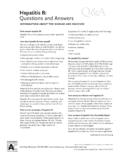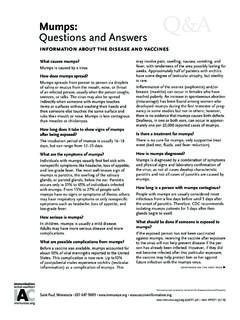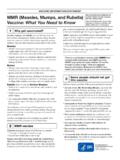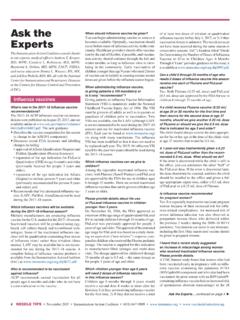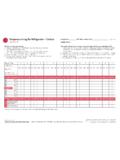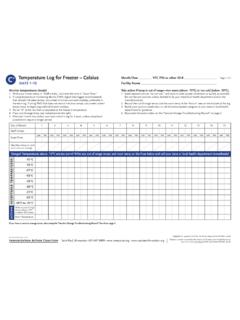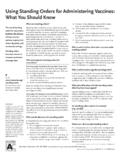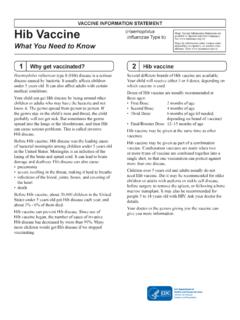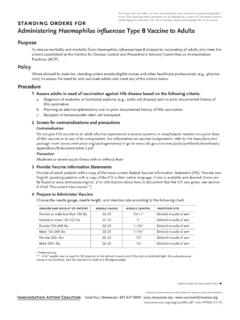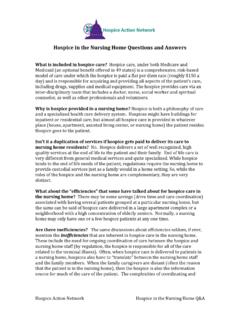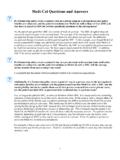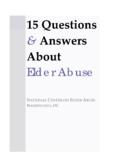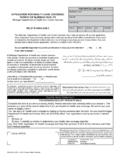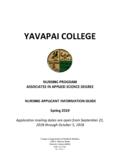Transcription of Influenza: Questions and Answers
1 Saint Paul, Minnesota 651-6 47-9009 Item #P4208 (10/19)What causes influenza ? Viruses cause influenza . There are two basic types, A and B, which can cause illness in humans. Their genetic material differentiates influenza A and B viruses. Both influenza A and influenza B can cause mild to severe illness in all age groups. While influenza A viruses infect humans and other animals, influenza B viruses affects only humans, primarily of the type A influenza virus are identified by two antigens ( influenza virus proteins called hemagglu-tinin [H] and neuraminidase [N]) on the surface of the virus. These antigens can change, or mutate, over time. Because these antigens change, people can get influ-enza infections multiple times over their lifetime. An antigen shift (major change) creates a new influenza A virus with a new H, or H and N, that can cause a global epidemic if the virus can spread easily among people and if most people do not have immunity against it.
2 This happened most recently in 2009 when the novel H1N1 influenza virus appeared and led to a major pandemic. How does influenza spread? influenza is transmitted through the air from the respi-ratory tract of an infected person when they talk, cough, or sneeze. It can also be transmitted by touch-ing a surface that has respiratory droplets with influ-enza viruses and then touching the nose, mouth, or possibly eyes. How long does it take to develop symptoms of influenza after being exposed? The incubation period of influenza is usually two days but can range from one to four days. What are the symptoms of influenza ? Typical influenza disease is characterized by sudden onset of fever, aching muscles, sore throat, and non-productive cough. Additional symptoms may include runny nose, headache, a burning sensation in the chest, and eye pain and sensitivity to light. Typical influenza disease does not occur in every infected per-son.
3 Someone who has been previously exposed to similar virus strains (through natural infection or vacci-nation) is less likely to develop serious clinical illness. Not everyone with influenza illness has a fever, espe-cially older adults. Some people may also have nausea, vomiting, or diarrhea; these symptoms are more often seen in children. How serious is influenza ? Although many people think of influenza as just a com-mon cold, it is really a specific and serious respiratory infection that can result in hospitalization and death. Rates of infection from seasonal influenza are highest among children. The risks for influenza -related compli-cations, hospitalizations, and deaths are highest among adults ages 65 years and older, children younger than 5 years, pregnant women, and people of any age who have medical conditions that place them at increased risk for complications from the 2010 11 through 2018 19 seasons, the annual influenza -related disease burden varied from 9 49 million illnesses, 4 23 million medical visits, 140,000 960,000 hospitalizations, and 12,447 79,400 deaths per year.
4 The number of influenza laboratory-confirmed deaths in children reported to CDC aver-aged 122 (range 37 187) per year. This is considered an underestimate of actual pediatric deaths as some influenza -related deaths are likely not reported or rec-ognized. For more information on the health burden of influenza , see What are possible complications from influenza ? The most frequent complication from influenza are viral and bacterial pneumonia. Other complications include inflammation of the heart (myocarditis), brain (enceph-alitis) or muscle (myositis). influenza also can worsen chronic medical conditions like cardiovascular disease, leading to heart attacks or worsening congestive heart failure, and worsening asthma and diabetes. Reye syndrome is a complication that occurs almost exclusively in children patients suffer from severe vomiting and confusion, which may progress to coma because of swelling of the brain.
5 To decrease the chance Influenza: Questions and Answersinformation about the disease and vaccinescontinued on the next page of developing Reye syndrome, infants, children, and teenagers should not be given aspirin for fever reduction or pain relief. What is the best way to prevent influenza ? The best way to prevent influenza is with annual influenza there an alternative to vaccination in preventing influenza ? No. Vaccination is the single best way to prevent influ-enza and its complications. Some steps that may help prevent the spread of respiratory illnesses, like influ-enza, include: 1. Cover your nose and mouth with your sleeve or atissue when you cough or sneeze throw the tissueaway after you use it and then wash your Wash your hands often with soap and water, especially after you cough or sneeze. If you are not near water,use an alcohol-based hand Stay away as much as you can from people who If you get influenza , stay home from work or schoolfor at least 24 hours after the fever has ended.
6 If youare sick, don t go near other people to avoid infect-ing Try not to touch your eyes, nose, or mouth. Virusesoften spread this any drugs available to prevent or treat influenza ? There are six antiviral drugs approved for preventing or treating influenza in selected patients. Only four, oral oseltamivir (Tamiflu) and oral baloxavir (Xofluza), inhaled zanamivir (Relenza), and intravenous perami-vir (Rapivab) will provide protection against both A and B viruses. The other two, amantadine and rimantadine, protect only against the A viruses and are not recom-mended for use because of high levels of resistance to these of antiviral medications can reduce the severity and length of influenza illness. People with severe ill-ness and people at increased risk of severe illness ( , people at high risk of influenza complications, such as young children, people with chronic medical conditions, and older adults) should be treated with influenza antiviral medications when influenza is medicine is also recommended for use in cer-tain outbreak situations ( , nursing home out-breaks); in such cases, antiviral medication can be used for both treatment and prevention (also called prophylaxis).
7 It is important to remember that antiviral drugs are not a substitute for vaccination. CDC has more information on the use of influenza antiviral medications at I contract influenza , what should I do? Call your healthcare provider to discuss your particular situation. If you are at high risk of developing complica-tions from influenza , you should consult your health-care provider immediately if you develop influenza -like symptoms; you may benefit from influenza antiviral medicine. You will need to get plenty of rest and drink a lot of liquids. You can also take medications to relieve the symptoms of influenza (but never give aspi-rin to children or teenagers who have influenza -like symptoms, particularly fever). Antiviral medicines are most beneficial when started within the first 1 2 days of influenza illness. For purposes of treatment and pre-vention, antiviral medicines are prioritized for people at high risk for influenza -related complications, such as people 65 years or older, people with chronic medical conditions, pregnant women, and young children.
8 When is a person with influenza contagious? A person may pass virus from 1 day before symptoms start through 5 7 days after illness onset. Can you get influenza more than once? Yes. influenza viruses change frequently and infection with one strain does not provide protection against all strains. When did influenza vaccine first become available? The first influenza vaccine in the United States became available in 1945. What kind of vaccine is it? The most common influenza vaccine is made from inactivated (killed) viruses that are given as an intra-muscular injection. Two different influenza vaccines (cell-culture based inactivated vaccine and recombi-nant influenza vaccine or RIV) are made without the use of eggs. A nasal spray influenza vaccine containing live viruses that have been weakened (attenuated) is also available. influenza vaccine in the United States contains either 3 or 4 strains of influenza virus.
9 There continued on the next page influenza : Questions and Answers (continued) page 2 of 7 Immunization Action Coalition Saint Paul, Minnesota 651-6 47-9009 Item #P4208 (10/19)is no preference for one type of vaccine over another for people for whom more than one recommended and age-appropriate vaccine is are the vaccines made? Every year, researchers and manufacturers develop a vaccine that contains virus strains they believe will most likely circulate during the upcoming influenza sea-son. influenza vaccines contain both type A and type B viruses. For the inactivated (injectable) vaccine, the viruses are inactivated (killed), purified, and packaged in vials or syringes. Live attenuated influenza virus vaccine is packaged in a special nasal sprayer. Recombinant tech-nology is used to make recombinant influenza vaccine; this vaccine only includes one part of the influenza virus, the hemagglutinin, in the vaccine.
10 About six months are required to produce influenza vaccine each year. For more information about how influenza vaccines are made, see How is the vaccine given? The inactivated and recombinant vaccines are given as an intramuscular injection. The live attenuated vaccine is sprayed into the nose. Is the vaccine that contains 4 viruses preferred over the vaccine that contains 3 viruses? Most influenza vaccine available in the United States contains 4 strains of influenza virus. CDC and other groups do not have a preference for use of the 4-virus vaccine over the 3-virus vaccine. Who should get influenza vaccine? Annual influenza vaccination is recommended for all people ages 6 months and older who do not have a contraindication to the vaccine. What are the unique features of giving influenza vaccine to children compared with adults? Children ages 6 months through 8 years should receive two doses of influenza vaccine, separated by at least 4 weeks, the first time they receive this vaccine.
